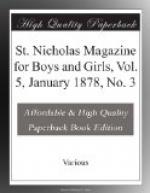But, as the years went on, these merry games died out, and a few years ago May-day was in London simply the festival of chimney-sweeps and milk-maids, certainly a falling off from the times of King Henry VIII. The only traces of the old custom of going a-Maying were the garlands of the milk-maids and the Jack-in-the-green of the sweeps. The garland (so called) was made of silver plate, borrowed for the day, and fastened upon a sort of pyramid. Accompanying this droll garland were the maids themselves in gay dress, with ribbons and flowers, and attended by musicians who played for them to dance in the street. Sometimes a cow was dressed in festive array, with bouquets and ribbons on her horns, neck and tail, and over her back a net, stuck full of flowers. Thus highly ornamented, the meek creature was led through the streets.
The sweeps brought out the Jack-in-the-green, which was a tall cone made of green boughs, decorated with flowers, gay streamers and a flag, and carried by a man inside. Each of these structures was followed by a band of sweeps who assumed certain characters, the fashion of which had been handed down from the palmy times of May-day.
There were always a lord and lady who wore ridiculous imitations of fashionable dress, and made ludicrous attempts to imitate elegant manners. Mad Moll and her husband were another pair who flourished in tawdry, gay-colored rags, and tatters, he brandishing a sweep’s broom and she a ladle. Jim Crow and a fancifully bedizened ballet-dancer in white muslin, often swelled the ranks, and the rest of the party rigged out in a profusion of gilt paper, flowers, tinsel and gewgaws, their faces and legs colored with brick-dust, made up a comical crowd. But even these mild remains of the great festival are almost entirely banished to the rural districts, and are almost extinct there.
Poor Flora! (if there ever was such a person) she has her wish (if that wish ever existed save in the imagination of the Romans); she is not forgotten; her story survives in musty books, though her personality be questioned; various marble statues bear her pretty name, and, after running this declining scale through the ages, she and her May-day are softened by time to a fragrant memory.
WILD GEESE.
BY CELIA THAXTER.
The wind blows, the sun shines, the birds
sing loud,
The blue, blue sky is flecked with fleecy
dappled cloud,
Over earth’s rejoicing fields the
children dance and sing,
And the frogs pipe in chorus, “It
is spring! it is spring!”
The grass comes, the flower laughs where
lately lay the snow,
O’er the breezy hill-top hoarsely
calls the crow,
By the flowing river the alder catkins
swing,
And the sweet song-sparrow cries, “Spring!
it is spring!”
Hark, what a clamor goes winging through
the sky!
Look, children! Listen to the sound
so wild and high!
Like a peal of broken bells,—kling,
klang, kling,—
Far and high the wild geese cry, “Spring!
it is spring!”




